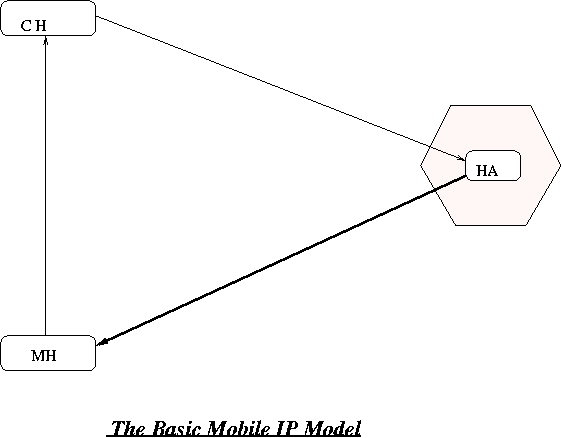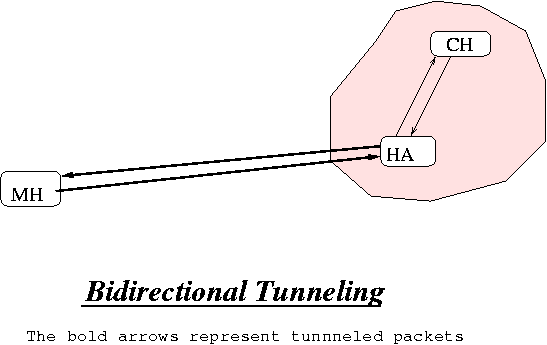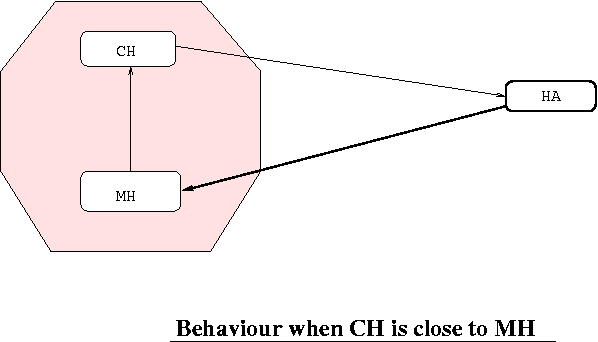CS625 - Advanced Computer Networks
Lecture 17 (12th September 2003 )
Scribe - Kumar Avijit
Roll # Y0170
Overview:
- Mobile IP (recapitulated)
- Source Address Filtering and Bi-directional Filtering
- Simultaneous Bindings
- Optimizations:
- Minimizing Latency
- Minimizing Size of packet
- Choices with the mobile host.
- Choices with the correspondent host.
The goal of mobile IP is to
enable the mobile host send and receive packets addressed with its home
IP address, regardless of where the host resides. The idea is to
separate address and location. This has been accomplished in mobile IP
by means of having 2 addresses:
- The original IP address of the host.
- A care-of-address that is assigned to the host when it enters a
foreign host. This address is assigned by the foreign host.
The basic model of the mobile IP infrastructure can be outlined by
means of the following figure:

The bold arrow represents a tunneled IP packet. the normal arrows
represent normal packets. CH is the correspondent host, HA is the home agent and MH is the mobile host. No tunneling is
required if the MH is in the same administrative domain as the HA.
Tunneling is required if MH is inside a foreign network because an
untunneled packet coming from HA to MH bearing the source address
of CH might be dropped by the border routers of the foreign network.
Packets from MH to CH do not require any tunneling as MH can send the
packets directly to CH without having the need to send them via HA.
Source
Address Filtering and bidirectional tunneling:
The home agent encapsulates the correspoondent host's packets and
correctly forwards them to the mobile host. The mobile host's replies
will however fail to reach the CH if it uses the home address as the
source address due to ingress filtering at the CH. To avoid this
problem, the MH should use reverse tunneling to send replies to CH.
This is called Bidirectional tunneling.

Simultaneous
Bindings:
A mobile host can register multiple bindings simultaneously. The home
agent makes multiple copies of packets destined for the mobile host,
and tunnels a copy to each care-of-address.
Simultaneous bindings may be used to :
- facilitate seamless hand-off.
- avoid too frequent registrations.
Optimizations:
Consider the case when MH is close to the CH as in following
figure:

In the above case, if the CH knows about its proximity with the MH, it
can send packets directly to MH thus saving the extra distance of
sending them via HA. Two ways have been proposed to make the CH smart
enough to know of the care-of-address of the MH. The first is that when
the HA forwards the packet to the MH, it may also send an ICMP message
to the CH telling it of the care-of-address of MH. The second approach
is an extension to DNS similar to the current MX records. The mobile
agent, if it is not changing its location too frequently, can register
its care-of-address with the extended DNS. The CH looks up the hostname
and sees that it has a care-of-address also. So it sends the
packet directly to the care-of-address.
Tunneling a packet generally requires adding 20 bytes to the packet. If
doing so makes the packet exceed the MTU, the packet needs to be
fragmented, doubling the packet count. Thus encapsulation should be
avoided wherever possible.
4
* 4 choices:
To achieve mobility transparency and successful delivery in security
conscious networks, we use encapsulation. Though encapsulation
increases size of packet, it has advantages also as we can change
the source address and destination address easily. The MH can then use
the home IP address as the source address of the inner packet and the
care-of address as the source address of the outer packet. There is
another issue as to who should perform decapsulation. The MH can be
sure of this service from its HA but sending each packet through the HA
will sometimes lead to a considerable increase in the distance the
packet travels through. If the MH sends the encapsulated packet
directly to the CH, it will first have to make sure that the CH can
decapsulate it.
Thus the MH has 4 choices to choose from in case of outgoing packets:
- Direct, encapsulated :In case of a decapsulation capable host. s
= COA, d= D=CH. S=Home address
- Direct, unencapsulated: S=COA, D=CH
- Direct, unencapsulated: S=Home address, D=CH ( this will not work
with security aware routers)
- Indirect, encapsulated: s=COA, d=Home agent, S=home address,D=CH
In the above choices, s and d are the source and destination
addresses of the outer packet while their capital counterparts form the
addresses in the inner packet.
Just as choices exist for the mobile host while sending packets to CH,
similar choices exist for the corespondent host while sending packets
to the MH.
- Indirect, encapsulated.(CH is unaware of mobility of MH) The
packet will reach the Home network where it will be encapsulated by the
HA before forwarding to MH.
- Direct, encapsulated: (CH aware of mobile host). d=COA,D=Home
address, s=S=CH. In this case, the packet will be delivered directly to
the MH.
- Direct, Home address: (This is feasible only if MH and CH are
connected to the same network segment) S=CH, D=Home address.
- Direct, temporary address: S=CH, D=COA. In this case, the packet
is delivered directly without encapsulation overhead. However sending
packets this way forgoes the benefits of Mobile IP in that the
packets will be lost if the MH changes location.


